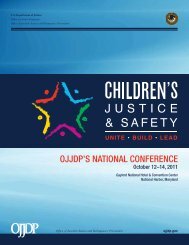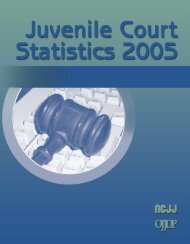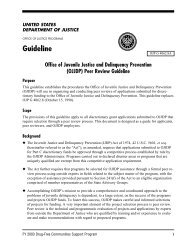OJJDP Family Listening Sessions: Executive Summary - Office of ...
OJJDP Family Listening Sessions: Executive Summary - Office of ...
OJJDP Family Listening Sessions: Executive Summary - Office of ...
You also want an ePaper? Increase the reach of your titles
YUMPU automatically turns print PDFs into web optimized ePapers that Google loves.
Common Themes and Reflections<br />
Participants in the listening sessions highlighted common themes and recommended<br />
improvements for the criminal and juvenile justice systems. The themes identified across the four<br />
listening sessions were:<br />
• Early warning signs were prevalent and should serve as critical prevention/intervention<br />
points for at-risk youth.<br />
• Lack <strong>of</strong> and inadequate communication and information from those working in the system<br />
are widespread issues that are major sources <strong>of</strong> frustration for families trying to navigate the<br />
system for the first time.<br />
• <strong>Family</strong> members commonly felt shame and guilt as a result <strong>of</strong> their treatment by law<br />
enforcement and other system <strong>of</strong>ficials. They were made to feel as if they were not good<br />
parents because their children had gotten into trouble.<br />
• When family members were included or consulted, it made a difference for the youth<br />
involved in the system.<br />
• When family members engaged with system representatives, it was <strong>of</strong>ten because <strong>of</strong> the<br />
perseverance <strong>of</strong> family members and, at times, in spite <strong>of</strong> system <strong>of</strong>ficials.<br />
Themes Based on the Families’ First Involvement With the System<br />
Use Critical Access Points for Prevention and Intervention<br />
The families in all <strong>of</strong> the listening sessions identified three key indicators that preceded their<br />
children’s entry into the system, which should serve as effective and critical access points for<br />
prevention and/or intervention <strong>of</strong> risky behaviors that may lead to detention.<br />
• Youth in elementary and middle school consistently exhibited early warning signs <strong>of</strong> at-risk<br />
behaviors before their first detention. Behaviors included truancy, a drop in grades, and<br />
evidence <strong>of</strong> mental health issues. Families believe that the school system is a critical access<br />
point for teachers, school counselors, and school resource <strong>of</strong>ficers to intervene, which<br />
schools can and should better support and encourage.<br />
• Schools, school resource <strong>of</strong>ficers, and law enforcement should consider truancy a symptom<br />
<strong>of</strong> youth heading for trouble rather than an enforceable <strong>of</strong>fense. During the listening session<br />
with tribal families, for example, many youth described episodes <strong>of</strong> dealing with<br />
discrimination and bullying in school as reasons for their truancy (see chapter 4).<br />
iii



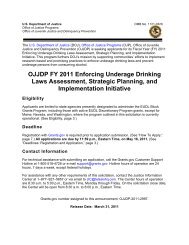
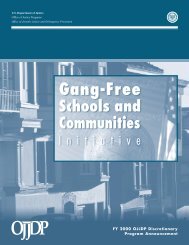
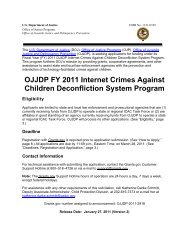
![Chapter 5 [PDF] - Office of Juvenile Justice and Delinquency ...](https://img.yumpu.com/46584340/1/190x245/chapter-5-pdf-office-of-juvenile-justice-and-delinquency-.jpg?quality=85)




